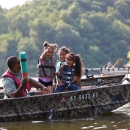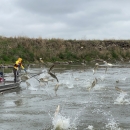Species that are considered high risk have a well-documented history of invasiveness in at least one location globally, and a high or medium climate match to the contiguous United States.
Parachromis managuensis has shown an ability to establish populations within the U.S. Although the impacts of this species in the U.S. are not well-studied, P. managuensis has been associated with declines of native fish species in multiple locations globally. Climate match to the contiguous U.S. is medium overall, but given reports of P. managuensis killed during cold winters even in southern Florida, the suitable locations for P. managuensis establishment in the contiguous U.S. are likely to be quite limited; however, the species may establish in thermal springs where the water is warmer than expected for the local climate. The overall risk posed by this species is high.



